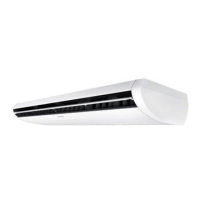9
ENGLISH
Performing leak test & insulation
Leak check
❈ The designs and shape are subject to change
according to the model.
LEAK TEST WITH NITROGEN (before opening valves)
In order to detect basic refrigerant leaks, before recreating the
vacuum and recirculating the R-410A, it’s responsable of installer
to pressurize the whole system with nitrogen (using a cylinder
with pressure reducer) at a pressure above 40 bar (gauge).
LEAK TEST WITH R-410A (after opening valves)
Before opening valves, discharge all the nitrogen into the system
and create vacuum. After opening valves check leaks using a leak
detector for refrigerant R410A.
Once you have checked that there are no leaks in the system, you
can insulate the piping and hose.
1
To avoid condensation problems, place Acrylonitrile Butadien Rubber
separately around each refrigerant pipe.
2
Wind insulating tape around the pipes and drain hose avoiding to
compress the insulation too much.
3 Finish wrapping insulating tape around the rest of the pipes leading to
the outdoor unit.
4 The pipes and electrical cables connecting the indoor unit with the
outdoor unit must be xed to the wall with suitable ducts.
All refrigerant connection must be accessible, in order to permit either unit maintenance or removing it completely.
CAUTION
No gap
EPDM, NBR
Leak test
Insulation
Insulation cover pipe
Indoor unit
Be sure to overlap the
insulation
Insulation pipe
Must t tightly against body
without any gap.
CAUTION
Always make the seam of pipes face upwards.
NOTE

